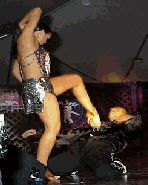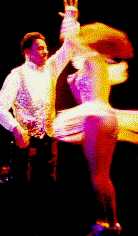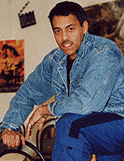|
|
|
Talking about Salsa!
Take your TURNS to the next level!!! By Angel Ortiz |
|
To take your TURNS to the next level, you need to learn two of the key elements of Dance - Spotting and Focus!!! Whether you find yourself dancing in a social or professional environment, there are two key elements of dance that are applied constantly. They are known as "Spotting" and "Focus". If you are in the beginning stages of your pursuit in dance, you should concentrate on developing these elements. If you are in the advanced stages of dance, this can serve as review material. Every turn or spin requires the dancer to focus on keeping his/her balance. This is achieved through focus and spotting. Other elements also include body alignment and placement of the arms. For the purposes of dancing Salsa/Mambo, we borrow Focus and Spotting from other dances such as Jazz and Ballet. However, they can be incorporated in almost all types of dance. Remember that the art of dancing is evolutionary. Borrowing technique from other dances is a great way to experiment and create new forms and ideas.  As it relates to dancing the Mambo, turning once or twice within a measure of music is the norm. However, to enhance your dancing, you can expect to incorporate additional turns. Letís look at it from a musical point of view. Most of the music salseros dance to is written in 4/4 timing. That means that there are four beats in each measure. We use two measures to complete a full basic step. Therefore, we count from one to eight. In partner work or when dancing independently, you can begin the turns in either measure. However, most times itís preferred to commit to spins or turns when going into the second measure of the 4/4 timing. This allows you (the person turning) the preparation needed to complete the turn/spin comfortably. Preparation is employed since it provides for application of technique, including correct placement of weight and positioning of the feet. (There is more to turning than you thought, huh?) So how does one apply focus and spotting, you ask? Well, basically spotting is applied when you are turning solo or are caused to turn. Spotting is the act of causing your head and eyes to "start first" and "finish first" throughout the sequence of spins while keeping your body centered. Whatís important about spotting is that you learn how to "separate" your head from your body as you turn. The effect of not spotting is dizziness. Also, since the head is heavy, it needs to be controlled as you cause your body to spin or turn. At first, you will feel the effect of dizziness. Since our eyes are like the lens on glasses and cameras, you will find yourself going out of focus and then back into focus. Eventually, youíll become more accustomed to focusing your eyes and balancing your body to accomplish single or multiple turns.  There are several exercises you can practice in order to improve your spotting and focus. Some are stationary exercises and others require traveling from one spot to another. Two have been chosen for this article. They are suggested exercises and by no means the last word in focus and spotting. Iím sure if you ask around, youíll be referred to other exercises, equally or more advanced. You can try these at home but it is best to practice in a dance studio to prevent injury from bumping into the furniture. Obviously, the exercises require ample space and if done in the home, it is recommended you remove the furniture and any objects that may get in your way. Letís begin with a stationary exercise. Weíll start with turning left. While standing straight, turn your head toward the left shoulder. Follow by turning your shoulders in that same direction while simultaneously taking small steps. Keep this motion going until you find you canít turn your head anymore without bringing your shoulders with you. At this point, bring your shoulders and the rest of your body to meet with your head for a complete turn (you should be at your starting point) This exercise will help you to "separate" the head from the body. This action should eventually help you reduce some of the dizziness that occurs during the learning stages. In addition, it should also ultimately create a "snap" in your turns. Visually, people will see the head whip around before the rest of the body catches up. Like most basic exercises, this stationary exercise is very helpful toward achieving your goal. This exercise is performed slowly so you wonít need the arms for balance yet. You can keep your arms at your sides while you work on isolating your shoulders, the steps, and your head. The second exercise requires you to move in space. Weíll turn to the right this time. Your goal is to reach the other side of your space while traveling in a straight line. Pick a starting point, then turn your head to the right and focus on an object; a wall, a picture, a person, or a spot (hence spotting). Use this object as a focal point. Apply the same elements from the first exercise and remember to keep your arms raised and aligned with your ribs (I call it the mambo position) as you make your way across the floor. Your steps should be very small and tight while you travel on the balls of your feet. Keep your stomach in and use your inner thighs for assistance. Think of these turns as "Pencil" turns. The name comes from the way the body takes the shape of a pencil while you are turning. These so-called "pencil" turns are very similar to the kind that almost everyone does while dancing. There are exceptions, but for the most part, you should keep both feet on the ground while executing multiple turns (the other options are pirouettes as done in ballet or jazz - but this is not the norm for mambo dancing). Like everything else - Practice, Practice, Practice - will make your turns perfect!!!!!! Author's Note: My thanks go to StreetDance Australia for the opportunity to contribute their free online books. To the reading public, my thanks go to you for your continued support and for visiting with StreetDance. A special thankyou goes to my dance partner Rebecca Sweet who appears in this article's photos. |
 Angel Ortiz Visit his website! |
Angel Ortiz is a professessional dancer, international dance instructor, choreographer and is an author who in his
unceasing energy contributes articles to ezines around the world.
He is a man with a mission - to ensure that Salsa music and dance stays on the world stage!
For six years he was a principle dancer with the Eddie Torres Dance Company (New York) and now is an Official dance instructor for the Bacardi Congreso de La Salsa. Angel, also teaches mambo for DanceSport!
| |||||
|
Press Ctrl-D to Bookmark this page!
Something new will appear at StreetDance most months. Stay up-to-date! Sign up for our free newsletter! Email us! If you enjoyed StreetDance's articles. Tell your friends about this site! Email them! If you found something lacking, tell us and it will be fixed! Tell us what you would like to read about! So talk to us! Feedback. StreetDance@mail.com |
Got a question? Click here! Want to know something more about Latin StreetDance click on one of the followng Dance History Mambo, Cha Cha & Salsa | Merengue | Samba Latin Dance Technique Feeling | Technique | Tricks & Tips | The Yambus | The Clave Basic Timing and Steps Mambo | Cha Cha | Salsa | Merengue | Samba Basic Choreography Mambo, Cha Cha & Salsa | Merengue | Samba Other Stuff Articles | Gig Guides | Dance Videos | Classifieds | Links | Home |
copyright Paul F Clifford (2001)

